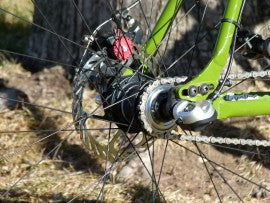
Single-speed mountain bikes are a fun and challenging change from normal geared bikes, but the lack of gears is really frustrating on flats. Going uphill is hard as expected, and going downhill you can coast fast, but on the flats you spin your pedals and go nowhere.
I decided to add an internally geared 3-speed hub to my single-speed. I thought I might be able to keep the clean, quiet, and solid feel of the single-speed, but get a bigger gear for the flats.

I started with a 2007 Redline Monocog Flight 29er single-speed. This cost around $800 and was purchased in early 2008. It came with a 32 tooth chainring and 20 tooth rear cog for a 1.60 gear ratio. That 32x20 gearing with the 29" wheels is probably similar to 32x22 on a 26" bike. The photo on the right below shows the original rear wheel.

The hub I chose for this bike is the Shimano Nexus Inter-3 for $125. This has an overall gear range of 186% and a stated weight of 945 grams (2.1 pounds). A normal good rear mountain bike hub weighs 300-350 grams, so the Inter-3 adds at least 600 grams (1.3 pounds). This hub works with disk brakes.
The hub does not include ... a shifter, so I purchased the Shimano Nexus SL-3S42 3-Speed Revo Shifter and Bell Crank for $20. This is the only choice as far as I know.
The hub includes a 19 tooth cog, but I wanted an 18, so I ordered a Shimano Nexus 18 tooth cog for $5. This cog seems to work well with the old chain/chainring.
Rather than taking the used brake rotor off the old wheel, I bought a new Avid G2 Clean Sweep Bicycle Disc Brake Rotor for $27. To mount this on the Inter-3 hub I needed a Shimano Centerlock to 6-Bolt Rotor Adaptor for $29.
The 32-hole hub was built into a wheel by Dave Thomas (Dave's Wheels, SpeedDream.com). I have had numerous sets of wheels built by Dave, and found them to be the sturdiest lightweight wheels ever. I still ride all of them, and have rarely (if ever) had to put a spoke wrench to any of them.



The tables below show various calculations related to gear ratios.
The first section is gear ratios for my 27-speed 29er. The ratios vary from 0.65 to 4.00, which is a total of 618%. This is really what you need for a long ride in Colorado to push the bike 40-45 mph down a hill and also to crawl up a long steep climb. Note that the original 32x20 gearing of the Redline Monocog is right in the middle of this table.
The next section shows different gear ratios with an internally geared hub and different rear cogs. I went with an 18-tooth cog, which compared to the original 32x20 gives me a slightly easier 1st gear, but mostly gives me a bigger 3rd gear.
The last section is bike speed (for a 29er) versus pedal cadence (rpm) for different gear ratios. With the original 32x20 gearing I had to spin at 80 rpm just to go 11 mph. Now my 3rd gear gets me 16.5 mph at 80 rpm.
Assembly was pretty easy. The Inter-3 seems simple and well-built. The bell crank moves a push-rod in/out of the center of the axle to change gears.
One concern is that the bell crank seems pretty exposed. I could easily see hitting it on a rock and breaking it off. A future task would be to fashion some sort of shield to protect the bell crank.
Initial impressions from riding are very positive. The Inter-3 is very quiet and solid feeling. When you change gears you don't really notice it is there, but just notice that the pedaling effort is different.
Upshifting (into a higher/harder gear) is amazing. The pedaling effort just changes instantly with virtually no noise or delay. Does not seem to matter if you are applying pressure to the pedals or not.
Downshifting (into a lower/easier gear) is quieter than a normal derailleur setup, but does usually make a little noise. Downshifting does require that you take pressure off the pedals. Under pressure the hub just does not shift, so you have to briefly stop pushing. I wish it was the other way around (downshifting under any pressure and upshifting requiring low pressure).
